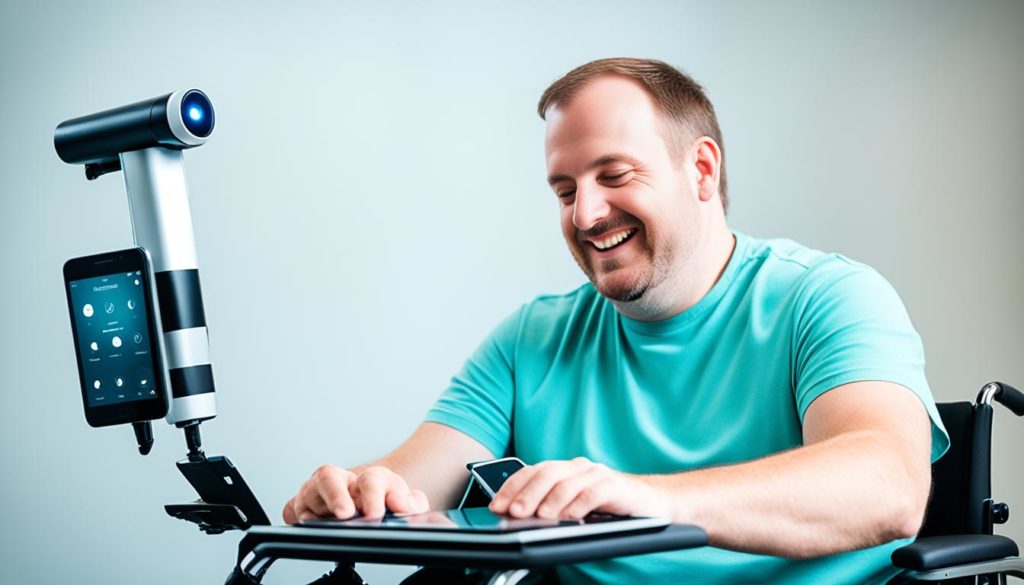
Nearly 61 million adults in the United States have a disability. As we move towards a more digital world, making technology accessible is crucial. The Americans with Disabilities Act (ADA) made big steps in 1990. But, the digital world has changed a lot since then. This brings both challenges and chances to make the web accessible for everyone.
About 25% of people in the U.S. struggle to use digital services. This is a step back from the progress the ADA made. There’s been a rise in lawsuits over digital accessibility. This shows how important it is for businesses to focus on making tech more accessible. Even small changes can greatly help in making digital spaces open to all.
Key Takeaways
- 61 million U.S. adults live with a disability, emphasizing the need for accessible technology.
- The ADA’s initial focus on physical spaces now extends to the digital world.
- 25% of the population faces challenges with current digital interfaces.
- Increased lawsuits point to the urgency of addressing digital barriers.
- Prioritizing web accessibility can offer businesses a competitive advantage.
The Importance of Tech Accessibility
Digital accessibility is more than following the law; it shows deep care for social responsibility. When more people can use tech products, companies not only grow their customer base but also show they value inclusivity.
Social Responsibility
Today, social responsibility drives business success and longevity. Ensuring tech is accessible shows we care about equal chances for those with disabilities. The World Health Organization says over 1 billion people have a disability, which is about 1 in 8 people worldwide. This makes accessible technology essential, not optional.
Using assistive technologies like screen readers and voice recognition helps those with disabilities. It makes digital areas easier for them and builds a supportive environment. In the U.S., about 6% of people have a major hearing problem and around 5% have severe sight issues. Making technology accessible allows everyone to join in the digital world.
Legal Compliance
Being accessible online is not just good ethics; it’s also the law. Not following ADA guidelines can lead to big fines and legal trouble. From the start of 2019 to mid-year, lawsuits related to ADA Title III jumped 12%. In the UK, not having an accessible website costs businesses £17.1 billion yearly.
Focusing on ADA rules lowers legal risks and dodges penalties for companies. Onfido, an accredited business by the Digital Accessibility Centre, is a good example. It follows WCAG 2.1 AA guidelines. Using customer feedback helps Onfido and others stay on top of accessibility standards.
Ignoring accessibility can push away a big part of the market. People with disabilities in the USA have about $490 billion in disposable income. This is a huge market, close to that of African Americans and Hispanics. Overlooking ADA rules is not only against the law; it’s a poor business choice. To learn more about the benefits of accessible tech, check out this detailed analysis.
Overcoming Digital Barriers
People with disabilities often struggle with digital worlds not built for them. Life gets harder when online tasks, like finding information or talking to services, are tough because of digital barriers.
Challenges Faced by Individuals with Disabilities
The digital era makes life easier for many. Yet, those with disabilities face problems when tech doesn’t meet their needs. Websites that don’t work with assistive technology, such as screen readers, are hard for people with sight issues to use. Not having subtitles on videos makes the internet hard for those with hearing issues.
Impact on Daily Life
Digital barriers greatly affect those with disabilities. Simple things, like shopping online or setting up a doctor visit, can get very complicated. This means many people don’t get to fully join our digital world. Using inclusive technology helps everyone get to the online information they need.
Examples of Digital Barriers
There are many kinds of digital barriers:
- Web Forms: Screen reader-unfriendly forms block visually impaired users from doing tasks they need to.
- Media Content: Lack of captions or transcripts keeps out those with hearing challenges.
- Design Elements: Motor skills issues make it tough for some to use features like sliders or drag-and-drop.
We must work to lower these digital barriers for a welcoming and accessible digital space. Assistive technology plays a big role in making online activities easier for everyone.
Benefits of Digital Accessibility
Digital accessibility brings many advantages. Starting with inclusive web design makes everyone’s experience better. It’s crucial to see how accessible design aids not just those with disabilities but also improves how we all navigate and interact online.
Enhancing User Experience
Websites that are easy to use are the goal of accessible design. This approach caters to various needs, including those of the elderly, kids, and people with temporary disabilities. Google likes to put accessible sites higher in search results, which brings in more people. Accessible design isn’t only about meeting standards; it’s about making websites welcoming and easy for everyone. With 61 million adults in the U.S. living with a disability, a smooth online experience breaks down barriers and promotes fairness.
Broadening Market Reach
Accessibility in digital spaces opens your business to more customers. In the U.S., adults with disabilities have about $500 billion to spend. This is a big group of people that businesses haven’t fully reached yet. Being inclusive also appeals to over a billion people globally. Millennials, especially, like supporting businesses that share their values. Being accessible can help draw this group in, increasing loyalty and sales.
Legal and Ethical Considerations
Following laws like the Americans with Disabilities Act (ADA) and World Wide Web Consortium (W3C) guidelines is the right thing to do. It also shows you care about doing business responsibly, which attracts customers who value that. There were over 10 digital accessibility lawsuits filed every day in 2021, showing the risks of ignoring these laws. Making your website accessible from the start saves money and enhances your reputation. Plus, 88% of customers stick with brands that support good causes, showing how much people value ethics in business.
Choosing accessible design is a smart move. It improves the experience for users, reaches more customers, and meets ethical and legal standards. Digital accessibility benefits society and businesses by making technology open and fair for all.
| Benefit | Description | Impact |
|---|---|---|
| Enhance User Experience | Improves navigation, readability, and interaction for all users. | Increases engagement and satisfaction. |
| Broaden Market Reach | Opens access to a significant demographic, including individuals with disabilities. | Capture a $500 billion market in the U.S. alone. |
| Legal Compliance | Adheres to ADA and W3C guidelines to avoid lawsuits. | Reduces legal risks and costs associated with non-compliance. |
Implementing Accessible Design Principles
Accessible design principles are crucial for the full potential of tech accessibility. The POUR framework by the World Wide Web Consortium (W3C) offers guidelines. It helps create digital content that is perceivable, operable, understandable, and robust.
Perceivable, Operable, Understandable, Robust (POUR) Framework
Federal agencies must develop accessible tools, products, and websites. They use the POUR framework to make content accessible to everyone, including those with disabilities. Content is made perceivable by providing text for non-text content and captions for videos. It’s made operable by ensuring keyboard access, and understandable and robust by clear navigation and adaptable presentation.
Simple Changes for Significant Impact
Adding descriptions to images and ensuring colors are not the only way to convey information helps accessibility. Usability testing, with users who have disabilities, spots and fixes issues early. Organizing content with clear titles and headings helps all users navigate better.
Design and testing should focus on feedback from people with different disabilities. This ensures digital products work well for a wide range of users. The video series on “Introduction to Universal Design for Content” offers guidance. Accessible design saves money, promotes inclusivity, and builds loyalty over time.
FAQ
What is tech accessibility and why is it important?
Tech accessibility makes sure everyone can use digital tools, including those with disabilities. It’s important as it supports fairness, offers equal opportunities, and avoids legal issues with ADA compliance.
How does digital accessibility relate to social responsibility?
Digital accessibility shows our promise to make tech open for all. It helps everyone, no matter their ability, enjoy digital life. It’s a key part of being fair and removing barriers.
What are the legal implications of not adhering to web accessibility standards?
Ignoring web accessibility standards can cause legal troubles and big fines. Organizations should focus on ADA rules and use guidelines like W3C’s. This reduces legal risks and shows commitment to fairness.
What are some common digital barriers that people with disabilities face?
People with disabilities often find digital life tough. They struggle with bad form designs, screen readers that don’t work well, hard web navigation, and images without descriptions. These problems make using the internet hard for them.
How can improving digital accessibility benefit businesses?
Making digital content easier to access helps businesses in many ways. It betters user experience, reaches more people, and builds loyalty. Web design that includes everyone meets ethical goals and can boost profits and reputation.
What are some examples of assistive technologies that support digital accessibility?
Assistive tech like screen readers, speech recognition, and text-to-speech helps those with disabilities. These tools make surfing the web easier for them.
What is the POUR framework and how does it aid inclusive technology design?
The POUR framework stands for Perceivable, Operable, Understandable, and Robust. By using these ideas, developers can make websites and apps more accessible. This approach improves the experience for everyone.
What simple changes can businesses make to improve digital accessibility?
Easy improvements include adding descriptions to images, using clear fonts, allowing keyboard-only navigation, and providing video captions. These steps make a big difference for users with disabilities.
How can businesses ensure compliance with digital accessibility standards?
Businesses can stick to best practices, review their work often, and listen to feedback from disabled users. Following W3C guidelines is key for compliance and making the digital world open to all.
Future App Studios is an award-winning software development & outsourcing company. Our team of experts is ready to craft the solution your company needs.










